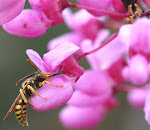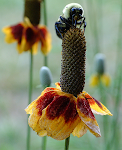
It was long assumed that the large regal bee sauntering around the hive was a King Bee. Then in 1586 some iconoclastic scientist noticed that the king was actually a queen, and that she spent most of her time laying eggs in the hexagonal cells of comb.
The queen is the center of the hive; all of the bees in her hive are bound together by her pheromone, or scent, that marks the hive's distinctive identity. If the queen is well, then the hive is well. Survival of the group depends on her ability to lay enough fertile eggs to produce the workers that care for the young, clean the hive, gather food, and make honey.
All of the latter jobs, by the way, are carried out by female worker bees. Male bees, or drones, have only one job: to hang around and mate with a fertile queen on her one and only "nuptial flight". That's right: the males just eat and have sex.
I'll say no more on that subject, but they do receive some form of comeuppance because they die after copulating; those that don't mate but just moon around hopefully get kicked out of the hive in fall when food is scarce.
The queen flies out of the hive only once, for an orgiastic mating flight where she can mate with multiple males. Afterward she comes home to the hive, carrying the sperm of all these mates. From this one flight she carries all the sperm she will use in her reproductive life.
After mating the queen lays eggs. Fertilized eggs become female workers; unfertilized eggs become beer-drinking, tv-watching Barcalounger dwelling males (ok that's not fair but I love the image). I should mention that somehow, mysteriously, the queen can
choose whether to lay fertilized or unfertilized eggs.
Right now my bees are setting up house. The worker bees are frantically building comb in which to lay eggs and store food. The bees make wax from glands on their bodies. To do this (not to mention to stay alive) they need food. Since they have nothing stored I must feed them sugar water (1:1 water to sugar).
Also the workers are freeing the queen; she was sent in her own little cage hung inside the package with all the workers. This is done to isolate her from them - these bees did not know this queen and consequently would kill her. Before this week, they identified with the queen pheromones from their home hives and would view mine as an impostor. After they've been around her for five days or so they will have imprinted on her scent.
She is now suspended in the hive in her little cage, one end of which is plugged with a piece of candy. The bees will eat this plug and free her; by the time they do so everyone will be a happy buzzing family. I hope.
I have two queens (one per hive) and have named them Elizabeth and Kathryn the Great. It is cold (46 F) and gray today. My bees are staying inside.
I put my ear to the hives and listened; there was industrious buzzing inside.






